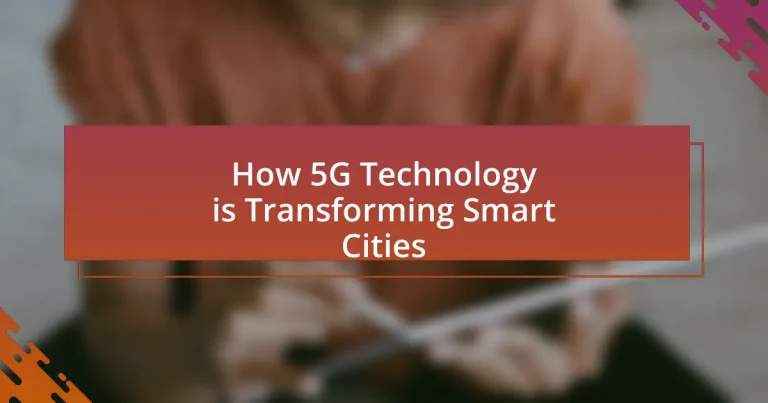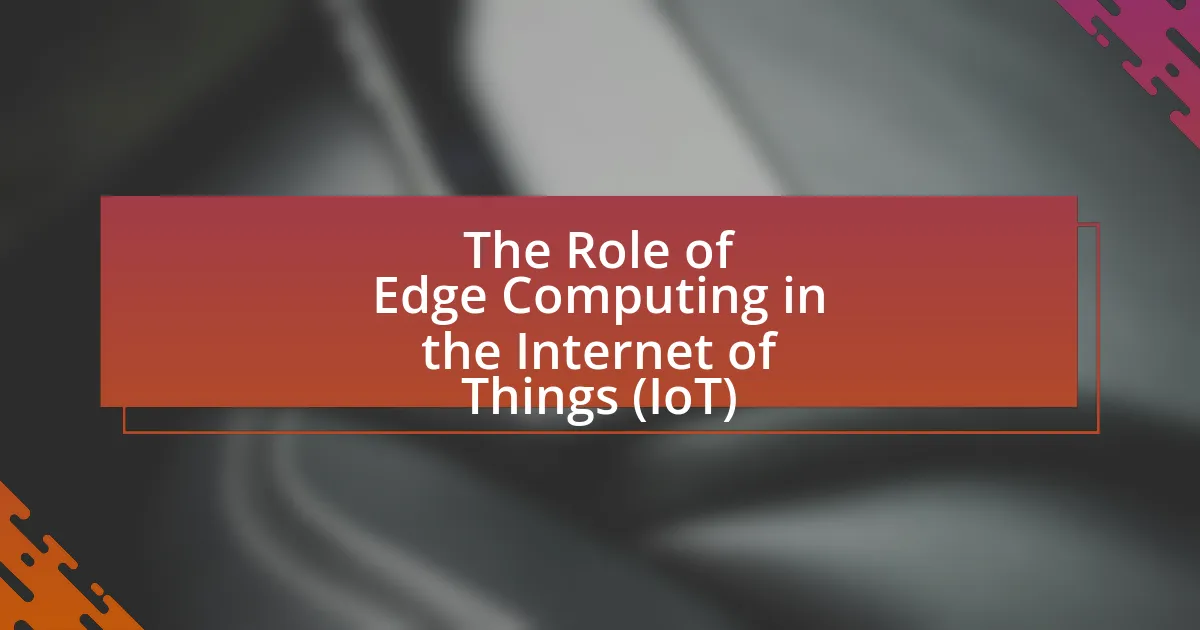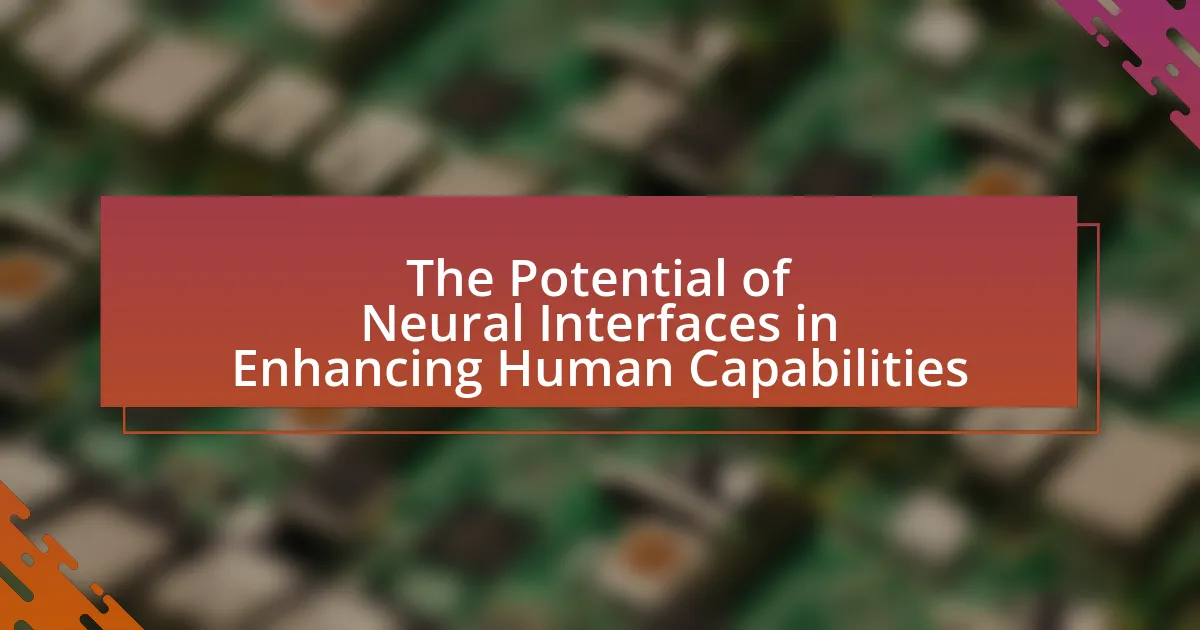5G technology is fundamentally transforming smart cities by providing enhanced data transmission speeds, lower latency, and the ability to connect a vast number of devices. This advanced connectivity supports critical applications such as real-time traffic management, energy distribution, and public safety systems, enabling cities to optimize resource usage and improve urban living standards. Key features of 5G, including massive device connectivity and improved network reliability, facilitate the integration of the Internet of Things (IoT), autonomous vehicles, and smart grids, ultimately enhancing the quality of life for residents. However, the implementation of 5G also presents challenges, including infrastructure costs, cybersecurity risks, and the need for equitable access, which cities must address to fully realize the benefits of this technology.
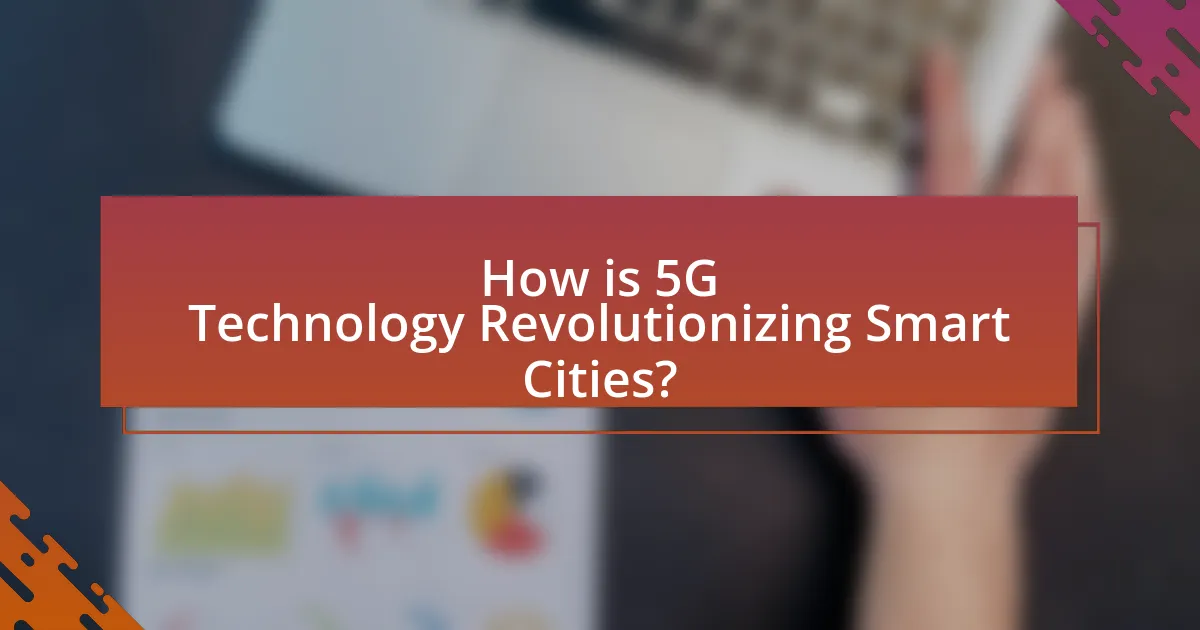
How is 5G Technology Revolutionizing Smart Cities?
5G technology is revolutionizing smart cities by enabling faster data transmission, lower latency, and increased connectivity for a vast number of devices. This enhanced communication infrastructure supports real-time data analytics, which is crucial for efficient traffic management, energy distribution, and public safety systems. For instance, a study by the International Telecommunication Union indicates that 5G can support up to one million devices per square kilometer, facilitating the deployment of IoT sensors that monitor environmental conditions and optimize resource usage. Additionally, 5G networks allow for the integration of autonomous vehicles, smart grids, and advanced public transportation systems, significantly improving urban living standards and operational efficiency.
What are the key features of 5G technology that impact smart cities?
The key features of 5G technology that impact smart cities include enhanced data speeds, low latency, massive device connectivity, and improved network reliability. Enhanced data speeds, reaching up to 10 Gbps, enable real-time data processing and analytics, which are crucial for applications like traffic management and public safety. Low latency, as low as 1 millisecond, allows for instantaneous communication between devices, facilitating applications such as autonomous vehicles and remote healthcare services. Massive device connectivity supports up to one million devices per square kilometer, essential for the Internet of Things (IoT) infrastructure in smart cities. Improved network reliability ensures consistent connectivity, which is vital for critical services like emergency response systems. These features collectively enable smarter resource management, improved urban planning, and enhanced quality of life for residents.
How does increased bandwidth enhance urban connectivity?
Increased bandwidth enhances urban connectivity by allowing more data to be transmitted simultaneously, which supports a higher number of connected devices and applications. This capability is crucial for smart city infrastructure, where real-time data exchange is necessary for efficient traffic management, public safety, and utility services. For instance, 5G technology can provide download speeds up to 10 Gbps, significantly surpassing previous generations, enabling seamless communication between IoT devices, such as smart traffic lights and surveillance systems. This improved connectivity leads to reduced latency and increased responsiveness in urban services, ultimately enhancing the quality of life for residents.
What role does low latency play in smart city applications?
Low latency is crucial in smart city applications as it enables real-time data processing and communication, which is essential for the efficient functioning of interconnected systems. For instance, low latency allows traffic management systems to respond instantly to changing conditions, optimizing traffic flow and reducing congestion. According to a study by the International Telecommunication Union, 5G technology can achieve latencies as low as 1 millisecond, significantly enhancing the responsiveness of smart city services such as emergency response, public safety, and autonomous vehicles. This rapid communication is vital for applications that rely on immediate data exchange to ensure safety and efficiency in urban environments.
Why is 5G essential for the development of smart cities?
5G is essential for the development of smart cities because it provides the high-speed, low-latency connectivity required for real-time data processing and communication among various smart devices and systems. This advanced network technology supports the massive data transfer needed for applications such as traffic management, energy distribution, and public safety systems. For instance, 5G can enable smart traffic lights to adjust in real-time based on traffic conditions, significantly improving urban mobility and reducing congestion. Additionally, studies indicate that 5G can support up to one million devices per square kilometer, facilitating the integration of numerous IoT devices that are crucial for smart city infrastructure.
How does 5G support the Internet of Things (IoT) in urban environments?
5G supports the Internet of Things (IoT) in urban environments by providing high-speed connectivity, low latency, and the ability to connect a vast number of devices simultaneously. This enhanced connectivity enables real-time data transmission and communication between IoT devices, which is crucial for applications such as smart traffic management, environmental monitoring, and public safety systems. For instance, 5G can support up to one million devices per square kilometer, significantly surpassing the capabilities of previous generations like 4G. This capacity allows cities to deploy a wide range of IoT sensors and devices, facilitating efficient urban management and improved quality of life for residents.
What are the implications of 5G for public safety and emergency services?
5G technology significantly enhances public safety and emergency services by providing faster data transmission, lower latency, and improved connectivity. This enables real-time communication and data sharing among first responders, which is crucial during emergencies. For instance, 5G can support high-definition video streaming from drones or body cameras, allowing command centers to assess situations more effectively. Additionally, the increased capacity of 5G networks facilitates the integration of Internet of Things (IoT) devices, such as smart sensors and surveillance cameras, which can provide critical information to emergency services. According to a report by the Federal Communications Commission, 5G networks can reduce latency to as low as one millisecond, which is vital for time-sensitive operations in public safety.
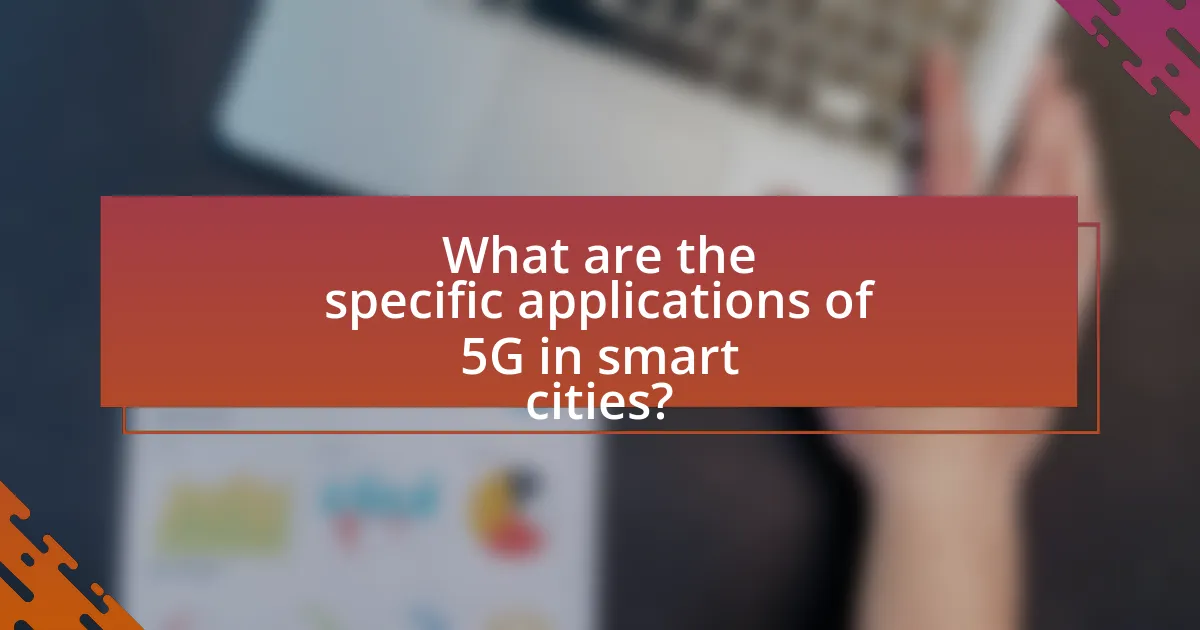
What are the specific applications of 5G in smart cities?
5G technology enables various specific applications in smart cities, including enhanced public safety through real-time surveillance and emergency response systems, improved traffic management via connected vehicles and smart traffic signals, and efficient energy management through smart grids. These applications leverage 5G’s high-speed connectivity and low latency to facilitate seamless communication between devices, allowing for immediate data processing and response. For instance, a study by the International Telecommunication Union highlights that 5G can support up to one million devices per square kilometer, significantly enhancing the capacity for IoT devices in urban environments.
How does 5G technology improve transportation systems in smart cities?
5G technology enhances transportation systems in smart cities by enabling real-time data communication, which improves traffic management and safety. With its high-speed connectivity and low latency, 5G allows vehicles to communicate with each other and with infrastructure, facilitating features like adaptive traffic signals and vehicle-to-everything (V2X) communication. This results in reduced congestion, optimized routing, and enhanced emergency response times. For instance, a study by the International Telecommunication Union highlights that 5G can support up to one million devices per square kilometer, significantly increasing the efficiency of connected transportation systems.
What innovations in traffic management are enabled by 5G?
5G technology enables several innovations in traffic management, primarily through enhanced connectivity and real-time data processing. These innovations include vehicle-to-everything (V2X) communication, which allows vehicles to communicate with each other and with infrastructure, improving safety and traffic flow. Additionally, 5G supports advanced traffic monitoring systems that utilize high-definition cameras and sensors to analyze traffic patterns and optimize signal timings. The low latency of 5G networks facilitates immediate responses to traffic conditions, enabling dynamic routing and congestion management. For instance, cities implementing 5G have reported reductions in traffic delays by up to 30% due to more efficient traffic signal control systems.
How does 5G facilitate autonomous vehicles in urban areas?
5G facilitates autonomous vehicles in urban areas by providing ultra-reliable low-latency communication, which is essential for real-time data exchange between vehicles and infrastructure. This technology enables vehicles to process information quickly, allowing for immediate responses to dynamic urban environments, such as traffic signals, pedestrians, and other vehicles. For instance, 5G networks can support vehicle-to-everything (V2X) communication, enhancing safety and efficiency by allowing vehicles to share information about road conditions and potential hazards. The low latency of 5G, often below 1 millisecond, significantly reduces the time it takes for vehicles to react, which is critical for autonomous driving.
What impact does 5G have on energy management in smart cities?
5G significantly enhances energy management in smart cities by enabling real-time data transmission and improved connectivity among devices. This advanced network technology allows for more efficient monitoring and control of energy consumption through smart grids, which can dynamically adjust energy distribution based on demand. For instance, a study by the International Telecommunication Union indicates that 5G can reduce energy consumption in urban environments by up to 90% through optimized resource allocation and reduced latency in communication. Consequently, the integration of 5G facilitates better energy efficiency, leading to lower operational costs and a reduced carbon footprint in smart cities.
How can 5G enhance smart grid technologies?
5G can enhance smart grid technologies by providing high-speed, low-latency communication that enables real-time data exchange between devices. This capability allows for improved monitoring and management of energy resources, facilitating faster response times to grid disturbances and optimizing energy distribution. For instance, 5G’s ability to support a massive number of connected devices simultaneously can enhance the integration of renewable energy sources, such as solar and wind, into the grid. Additionally, studies indicate that 5G can reduce latency to as low as 1 millisecond, which is crucial for applications like demand response and automated grid management, ultimately leading to increased efficiency and reliability in energy systems.
What are the benefits of real-time energy monitoring through 5G?
Real-time energy monitoring through 5G offers enhanced efficiency, improved reliability, and immediate data access for energy management. The high-speed connectivity of 5G enables devices to transmit data with minimal latency, allowing for instant analysis and response to energy consumption patterns. This capability supports dynamic load balancing and demand response strategies, which can lead to significant cost savings and reduced energy waste. Additionally, 5G’s ability to connect a vast number of devices simultaneously facilitates the integration of renewable energy sources and smart grid technologies, further optimizing energy distribution and consumption.
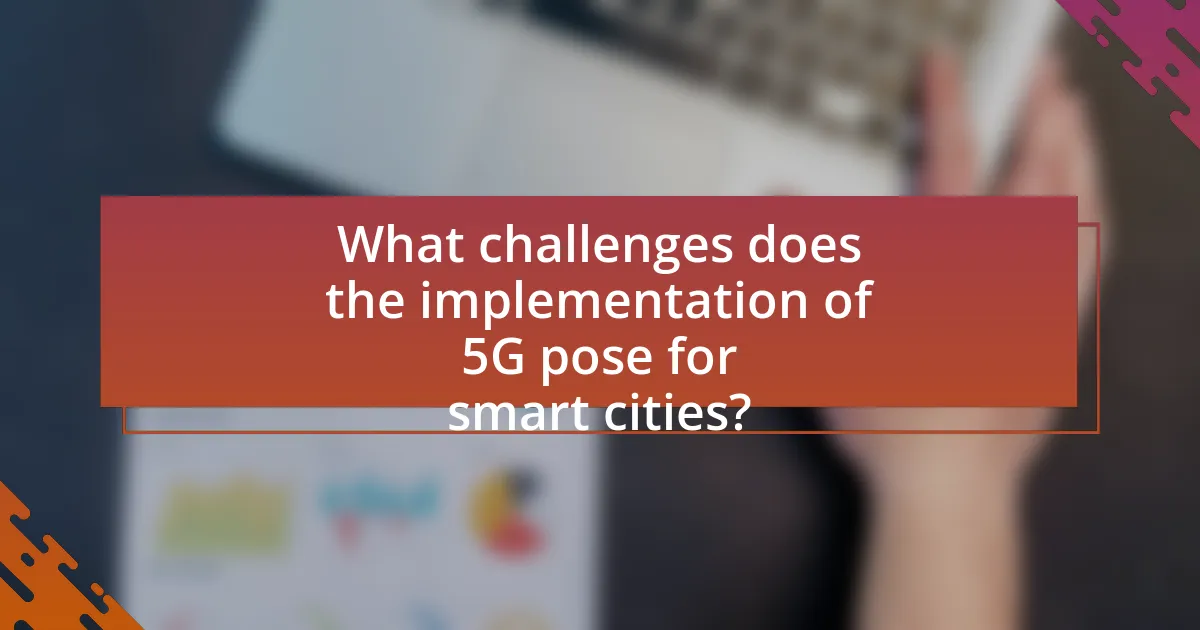
What challenges does the implementation of 5G pose for smart cities?
The implementation of 5G poses several challenges for smart cities, including infrastructure costs, spectrum allocation, and cybersecurity risks. Infrastructure costs are significant as cities must invest in new antennas and fiber-optic networks to support 5G technology, which can strain municipal budgets. Spectrum allocation is another challenge, as the demand for bandwidth increases, leading to potential conflicts over frequency usage among various stakeholders. Additionally, cybersecurity risks escalate with the increased connectivity of devices, making smart cities more vulnerable to cyberattacks. According to a report by the International Telecommunication Union, the complexity of managing these interconnected systems can hinder the effective deployment of 5G in urban environments.
What are the potential security risks associated with 5G in urban settings?
The potential security risks associated with 5G in urban settings include increased vulnerability to cyberattacks, privacy breaches, and the potential for infrastructure manipulation. The deployment of 5G technology expands the attack surface due to the proliferation of connected devices, which can be exploited by malicious actors. For instance, a report by the European Union Agency for Cybersecurity highlights that the complexity of 5G networks can lead to configuration errors and vulnerabilities that may be targeted. Additionally, the reliance on software-defined networking in 5G can create opportunities for unauthorized access and data interception, as evidenced by various cybersecurity studies indicating that the integration of IoT devices in urban environments can lead to significant data privacy concerns.
How can cities mitigate cybersecurity threats related to 5G?
Cities can mitigate cybersecurity threats related to 5G by implementing robust security frameworks, enhancing public-private partnerships, and investing in continuous training for personnel. Establishing a comprehensive cybersecurity strategy that includes encryption, intrusion detection systems, and regular security audits can significantly reduce vulnerabilities. For instance, the National Institute of Standards and Technology (NIST) provides guidelines that cities can adopt to strengthen their cybersecurity posture. Additionally, collaboration with telecommunications providers ensures that security measures are integrated into the infrastructure from the outset, addressing potential risks associated with 5G technology.
What measures can be taken to protect citizen data in smart cities?
To protect citizen data in smart cities, implementing robust encryption protocols is essential. Encryption secures data during transmission and storage, making it inaccessible to unauthorized users. For instance, the use of end-to-end encryption in communication networks ensures that only intended recipients can access the information, significantly reducing the risk of data breaches. Additionally, regular security audits and vulnerability assessments can identify potential weaknesses in the system, allowing for timely remediation. According to a report by the International Telecommunication Union, cities that adopt comprehensive cybersecurity frameworks experience a 30% reduction in data breaches, highlighting the effectiveness of these measures.
How can cities overcome infrastructure challenges for 5G deployment?
Cities can overcome infrastructure challenges for 5G deployment by investing in upgrading existing networks and collaborating with private sector partners. Upgrading involves enhancing fiber optic networks and ensuring adequate power supply to support the dense infrastructure required for 5G. Collaboration with telecommunications companies can facilitate the sharing of resources and expertise, which is essential for efficient deployment. For instance, cities like San Jose have successfully partnered with providers to streamline the installation of small cell technology, which is crucial for 5G coverage. Additionally, implementing regulatory frameworks that expedite permitting processes can significantly reduce deployment timelines, as seen in cities that have adopted streamlined policies for 5G infrastructure.
What role do public-private partnerships play in 5G infrastructure development?
Public-private partnerships (PPPs) play a crucial role in 5G infrastructure development by facilitating collaboration between government entities and private companies to share resources, expertise, and investment risks. These partnerships enable the pooling of financial resources necessary for the extensive infrastructure required for 5G networks, which can exceed billions of dollars in investment. For instance, the Federal Communications Commission (FCC) in the United States has recognized that such collaborations can accelerate the deployment of 5G by streamlining regulatory processes and leveraging public assets, such as government-owned land for cell towers. Additionally, PPPs can foster innovation by combining the agility and technological expertise of private firms with the regulatory support and public interest focus of government agencies, ultimately leading to more efficient and widespread 5G deployment in smart cities.
How can cities ensure equitable access to 5G technology?
Cities can ensure equitable access to 5G technology by implementing targeted infrastructure investments and inclusive policy frameworks. By prioritizing the deployment of 5G networks in underserved areas, cities can bridge the digital divide. For instance, the Federal Communications Commission (FCC) reported that low-income neighborhoods often lack adequate broadband access, highlighting the need for focused efforts. Additionally, cities can collaborate with private sector partners to subsidize costs for low-income residents, ensuring affordability. Programs that provide digital literacy training can further empower communities to utilize 5G technology effectively, enhancing overall access and usage.
What best practices should cities follow when integrating 5G technology?
Cities should prioritize comprehensive planning and stakeholder engagement when integrating 5G technology. Effective integration requires collaboration among government agencies, private sector partners, and community members to ensure that infrastructure meets the needs of all users. Additionally, cities should implement robust regulatory frameworks that address safety, privacy, and data security concerns associated with 5G deployment.
For instance, the Federal Communications Commission (FCC) emphasizes the importance of local governments in facilitating the deployment of small cell infrastructure, which is essential for 5G networks. Furthermore, cities should invest in training and education programs to equip their workforce with the necessary skills to manage and maintain 5G technology effectively.
Research indicates that cities that adopt a phased approach to 5G rollout, starting with pilot projects, can better assess the technology’s impact and scalability. This method allows for adjustments based on real-world feedback, enhancing overall effectiveness. By following these best practices, cities can maximize the benefits of 5G technology while minimizing potential challenges.
